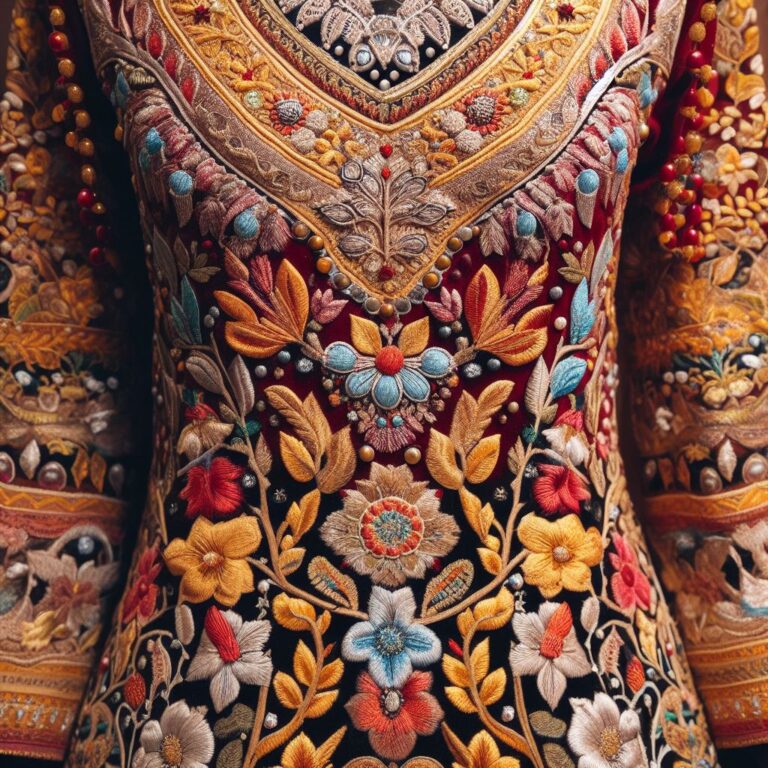Kashmiri Embroidery: Intricacy Woven Into Culture and Craft
Kashmiri embroidery, renowned for its exquisite craftsmanship and intricate designs, stands as a testament to the rich cultural heritage of the Kashmir Valley in India.
Dating back centuries, this traditional craft has captured the imagination of art enthusiasts worldwide.
In this article, we delve into the captivating world of Kashmiri embroidery, exploring its origins, techniques, motifs, and enduring legacy.
Table of Contents
Historical Roots and Cultural Significance
Kashmiri embroidery boasts a legacy steeped in history, with its roots tracing back to the Mughal era.
It gained prominence under royal patronage and flourished as artisans honed their skills, creating masterpieces fit for royalty.
Over time, Kashmiri embroidery became an integral part of Kashmiri culture, adorning garments, accessories, and home decor items, and reflecting the region’s artistic sensibilities.
Techniques and Materials
Kashmiri embroidery encompasses a wide array of techniques, each characterized by its unique stitches and patterns. The primary techniques include:
- Kashida Embroidery: This style features colorful, elongated stitches worked in floral and paisley patterns, creating a vibrant and intricate surface.
- Sozni Embroidery: Sozni is characterized by delicate, fine-threaded embroidery, often done with a single strand of silk or wool. It involves creating elaborate paisley motifs and intricate patterns on fabric.
- Aari Embroidery: Aari embroidery employs a specialized hooked needle, allowing artisans to create elaborate chain stitches. This technique is used to embellish shawls, sarees, and various garments.
- Tilla Embroidery: Tilla work incorporates the use of gold or silver threads, beads, and sequins, adding a touch of opulence to the embroidered pieces.
Traditionally, artisans use natural fibers such as silk, wool, and cotton as the base fabric, and vibrant threads made from silk or wool for embroidery.
The intricate needlework transforms plain fabric into a visual delight, showcasing the skill and artistry of the craftsmen.
Timeless Motifs and Designs
Kashmiri embroidery is renowned for its timeless motifs inspired by nature, Mughal art, and Persian influences.
Common motifs include blooming flowers, chinar leaves, birds, and paisley patterns, each carrying symbolic significance.
These motifs are meticulously embroidered, creating a harmonious blend of colors and shapes that captivate the beholder.
Global Recognition and Modern Adaptations
In contemporary times, Kashmiri embroidery has transcended geographical boundaries, gaining recognition on the global fashion stage.
Designers worldwide incorporate Kashmiri embroidery into their collections, celebrating the craft’s intricacy and elegance.
Moreover, artisans have adapted traditional techniques to create modern pieces, ensuring the art form’s relevance in today’s fashion landscape.
Preservation and Sustainability
Efforts are underway to preserve Kashmiri embroidery techniques and provide sustainable livelihoods to artisans.
Various organizations and cooperatives collaborate to empower craftsmen, promote fair trade practices, and preserve the authenticity of the craft.
Additionally, initiatives focusing on sustainable materials and eco-friendly practices contribute to the preservation of both the craft and the environment.
Kashmiri embroidery, with its centuries-old legacy and timeless appeal, continues to enchant art enthusiasts and fashion connoisseurs alike. Its intricate stitches, vibrant colors, and rich cultural heritage make it a cherished art form.
As artisans pass down their skills through generations and the world embraces sustainable and handmade creations, Kashmiri embroidery stands resilient, weaving together threads of tradition, creativity, and cultural pride, ensuring its enduring presence in the tapestry of global craftsmanship.
how to learn Kashmiri Embroidery
Learning Kashmiri embroidery can be a rewarding and creative experience. Kashmiri embroidery is known for its intricate designs and delicate craftsmanship. Here are some steps you can follow to learn Kashmiri embroidery:
1. Understand the Basics:
- Familiarize yourself with the history and different styles of Kashmiri embroidery. There are various styles like Kashida, Sozni, and Aari embroidery. Each style has its unique techniques and motifs.
2. Gather Supplies:
- Purchase the necessary supplies such as fine needles, embroidery threads in various colors, fabric (preferably cotton or silk), embroidery hoops, and beads or sequins if you plan to incorporate them into your designs.
3. Get a Stitch Guide:
- Find a comprehensive stitch guide or tutorial specifically for Kashmiri embroidery. There are many online resources, books, and video tutorials available that can guide you through different stitches and techniques.
4. Practice Basic Stitches:
- Start by practicing basic embroidery stitches like chain stitch, satin stitch, and stem stitch. These stitches form the foundation of most Kashmiri embroidery styles.
5. Take Online Courses:
- Enroll in online embroidery courses or workshops that focus on Kashmiri embroidery techniques. There are many platforms like Skillshare, Udemy, and YouTube where you can find tutorials ranging from beginner to advanced levels.
6. Join Embroidery Communities:
- Join online embroidery communities and forums where you can interact with fellow embroidery enthusiasts. Participating in discussions, asking questions, and sharing your work can provide valuable feedback and encouragement.
7. Practice Regularly:
- Like any other skill, practice is essential for mastering embroidery. Dedicate regular time to practice different stitches and work on small projects to enhance your skills.
8. Seek Feedback:
- Don’t hesitate to seek feedback from experienced embroiderers. Constructive criticism can help you identify areas of improvement and refine your techniques.
9. Experiment with Designs:
- Once you have a good understanding of basic stitches, start experimenting with your own designs. You can draw inspiration from traditional Kashmiri motifs or create your unique patterns.
10. Be Patient and Persistent:
- Embroidery, especially intricate styles like Kashmiri embroidery, requires patience and persistence. Don’t get discouraged if your initial attempts are not perfect. Keep practicing, and you will improve over time.
11. Visit Workshops or Craft Stores:
- If possible, attend embroidery workshops or visit craft stores where you can observe experienced embroiderers at work. Watching their techniques in person can provide valuable insights.
12. Document Your Progress:
- Keep a record of your embroidery journey. Take photos of your completed projects, make notes about the techniques you used, and document your progress. This will help you track your improvement and serve as a reference for future projects.
Remember, learning embroidery is a creative process, so allow yourself to enjoy the journey and don’t be afraid to experiment with different styles and colors.
With dedication and practice, you can become proficient in Kashmiri embroidery techniques.


0 Comments